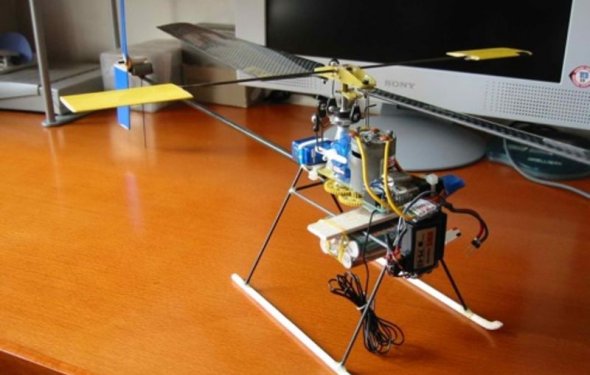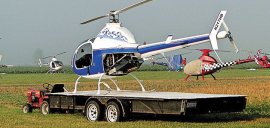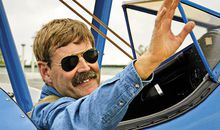Build it yourself RC helicopter kit

 Bell has built a Scorpion Too and an Executive, complete with trailer. (Joe Loxterkamp)
Bell has built a Scorpion Too and an Executive, complete with trailer. (Joe Loxterkamp)
When someone slaps down a hundred grand for a vehicle—a cigarette boat, say, or a sports car—there is usually some kind of red-carpet handover: a hearty handshake along with the keys, then a captain’s cap or a bottle of wine.
Not when the vehicle is a kit-built helicopter. In March 2009, Rod Harms’ helicopter-to-be arrived in eight crates stacked outside his ranch-style house near Pekin, Illinois. The delivery service left them in the nearest open space: the road. “Not by the road, in the road, ” says Harms. He called a friend to help hustle them out of traffic. The delivery, just eight days after the order had been placed with RotorWay International in Arizona, caught Harms with his hangar incomplete.
Four months later, he has finished the hangar, along with much of the aircraft’s frame and cabin. Bright, spacious, equipped with workbenches, power tools, and a concrete floor, Harms’ hangar is close to his house: His wife signed off on the project on the condition that he not build it after hours at his auto-body shop—she had the wifely intuition that she might not see him for months of Sundays.
One big crate stores dozens of lumpy, shrink-wrapped cardboard sheets. This is how RotorWay packages smaller parts like snap rings, pins, nuts, and bolts, which if shipped en masse in plastic bags could wind up in the wrong holes. Every part has a unique number to match a step in RotorWay’s notebooks and DVDs.
First clamoring for notice in brash, optimistic magazine ads of the 1950s (“Easy!” “Fun!” “Anybody who can ride a bicycle can fly this!”), the first viable home helicopter products came from Buford J. Schramm and Robert Everts, who designed the Scorpion (first named the Javelin) and began selling it in 1967 to hobbyists who wanted recreational rotary-wing flight but didn’t want to go the gyrocopter route with Bensen, Barnett, and other brands, or couldn’t afford a factory-built model. Two-seater Scorpion and later Helicom kits were challenging even for the mechanically gifted, but cost less than , 000 in 1975, one quarter the price of a Hughes 300 two-seater. Although this entry-level niche took a hit when the , 000 Robinson R22 production helicopter debuted in 1979, the homebuilt industry still sells hundreds of kits per year for construction under the Federal Aviation Administration’s amateur-built, experimental category.
 According to Homer Bell, who taught himself to fly in a two-seat RotorWay Scorpion Too in the first wave of kit-copter enthusiasm and is now a consultant to home helicopter builders, “There’s no single type of customer. They’re all over the place—doctors, farmers, not just people who don’t have enough money to get a production machine.” The kit helicopter community is much smaller than the fixed-wing kit builders, but the skills cross over: It’s not unusual to find helicopter builders whose stables house a Van’s RV-10 or other homebuilt airplane.
According to Homer Bell, who taught himself to fly in a two-seat RotorWay Scorpion Too in the first wave of kit-copter enthusiasm and is now a consultant to home helicopter builders, “There’s no single type of customer. They’re all over the place—doctors, farmers, not just people who don’t have enough money to get a production machine.” The kit helicopter community is much smaller than the fixed-wing kit builders, but the skills cross over: It’s not unusual to find helicopter builders whose stables house a Van’s RV-10 or other homebuilt airplane.
When all checks are done and forms completed, the customer finds that he or she is the manufacturer of a new aircraft, as well as its mechanic, notwithstanding the lack of an airframe-and-powerplant license. This has its pros and cons. On one hand, the sellers of such kits can be agile and adaptive, which helps keep production costs low. They can choose to ship whatever engine suits their fancy, or can leave the choice to the buyer, who could use a rotary engine from a Mazda RX-7 if he could adapt the power train. Since the FAA does not certify unassembled kit helicopter models as airworthy, it offers no opinion on such matters. On the other hand, in case of mishap, the customer’s number-one legal target is himself, as manufacturer and chief mechanic.
The word “kit” may conjure up childhood memories of assembling a Revell model from a cardboard box, building up each rotor with blades and a tube of glue. But when it comes to full-size helicopters, “build” is a more appropriate verb than “assemble.” While some parts must be cut, trimmed, or drilled, no arcane skills are necessary. It helps to start with a well-equipped workshop, a methodical style, and a familiarity with engines. Some companies, like Hummingbird maker Vertical Aviation Technologies, let customers add bucks to move up to a “quick-build kit” that cuts down on workshop time. But speed is not the point. Think of a big watch: RotorWay wants its customers to wield a micrometer and paper-thin shims to bring the hub and attached rotor blades (which stretch 25 feet tip to tip) to within .001 inch of perfect center.
“Some people should only be building wheelbarrows, ” says Al Behuncik, a RotorWay dealer in Alberta, Canada. “Their attitude is, ‘Well, it looks good enough to me!’ ” Behuncik spent 27, 000 hours building and flying the four aircraft in his “copter barn, ” coming up with improvements for the factory to adopt. Meticulous in his work, he has the gentle manner of a wrench-wielding Mr. Rogers, but his tone changes when discussing problems that are, in his view, easily avoidable. Behuncik says he sees two personalities that tend to get into trouble: “One is the person with no mechanical ability. The other is someone who just wants to get it done.”
While an old hand like Behuncik plans on spending 350 hours to bring a new A600 Talon from crate to flight, a newcomer is likely to spend twice that, or more. I heard tales of people for whom a decade of tinkering wasn’t enough. (Ads for the notorious Mini-500 single-seater kit from Revolution Helicopters claimed that owners could build one in 40 to 60 hours, but after a spate of well-publicized fatal crashes, hard landings, and hard feelings, Revolution folded in 1999.)